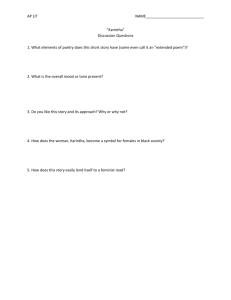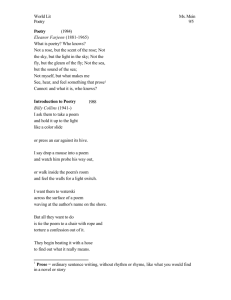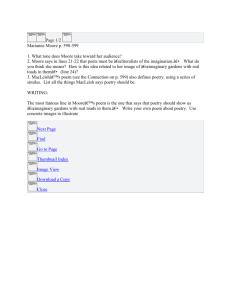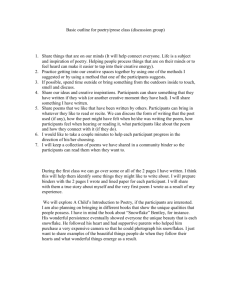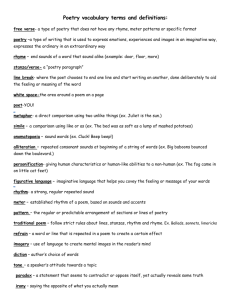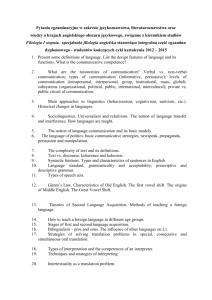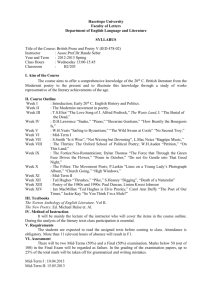Poetry Resource Sample - The English Experience
advertisement
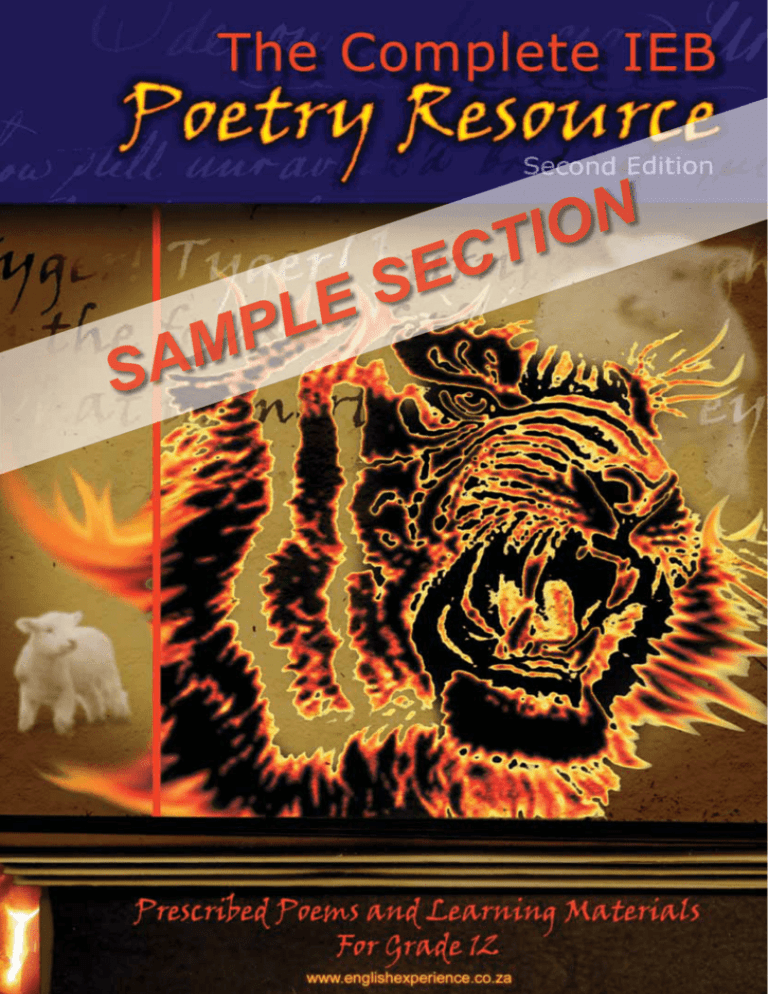
NEW RESOURCE combines rich context and analysis with carefully selected range of tasks that address all of the Matric IEB requirements. • Historical and literary contexts • Literary analysis • Content, contextual and essay questions, as well as varied enrichment tasks • Unique Act-based learning format • Section on exam readiness • Perforated rubrics • Rigorously annotated edition of the text included • Accompanying answers disc Enriching and challenging both educators and learners P R E S C R I B E D P O E M S A N D L E A R N I N G M AT E R I A L S F O R G R A D E 1 2 Foreword . . . . . . . . . . . . . . . . . . . . . . . . . . . . . . . . . . . . . . . . . . . . ..................................................................................... 7 INTRODUCTION TO POETRY TABLE OF CONTENTS Guide to reading, understanding and analysing poetry ....................................................................... 8 Guide to answering contextual poetry questions ............................................................................. 11 RENAISSANCE INTRODUCTION TO POETRY Introduction to the Renaissance Period ...................................................................................................13 Biography of William Shakespeare .........................................................................................................13 ROMANTIC RENAISSANCE SECTION Analysis of “When I do count the clock that tells the time” .......................................................................14 Questions on “When I do count the clock that tells the time” ....................................................................15 Biography of John Milton ......................................................................................................................18 VICTORIAN AND GOTHIC Poem: “When I do count the clock that tells the time” - William Shakespeare ............................................14 Analysis of “When I consider how my light is spent” ................................................................................19 Questions on “When I consider how my light is spent” .............................................................................20 BRITISH MODERNIST Poem: “When I consider how my light is spent” - John Milton ..................................................................18 Introduction to the Romantic Period .......................................................................................................24 Biography of William Blake ....................................................................................................................24 AMERICAN MODERNIST ROMANTIC SECTION Poem: “Ozymandias of Egypt” - Percy Bysshe Shelley..............................................................................33 Analysis of “Ozymandias of Egypt” .........................................................................................................33 Questions on “Ozymandias of Egypt” ......................................................................................................35 Biography of John Keats .......................................................................................................................39 Poem: “Ode to Autumn” - John Keats .....................................................................................................39 Analysis of “Ode to Autumn”..................................................................................................................40 Questions on “Ode to Autumn” ..............................................................................................................41 VICTORIAN AND GOTHIC SECTION Introduction to the Victorian and Gothic Periods ......................................................................................44 Biography of Emily Brontë .....................................................................................................................44 © THE ENGLISH EXPERIENCE 2011 SOUTH AFRICAN POST-APARTHEID Biography of Percy Bysshe Shelley .........................................................................................................32 UNSEEN POETRY Questions on “The Tyger” ......................................................................................................................27 WILD CARD QUESTIONS, VISUALS, RUBRICS Analysis of “The Tyger” .........................................................................................................................26 SOUTH AFRICAN APARTHEID Poem: “The Tyger” - William Blake .........................................................................................................25 3 THE COMPLETE IEB POETRY RESOURCE Poem: “Remembrance” - Emily Brontë ...................................................................................................45 INTRODUCTION TO POETRY Analysis of “Remembrance” ..................................................................................................................46 Questions on “Remembrance” ...............................................................................................................47 Biography of Matthew Arnold .................................................................................................................50 Poem: “Dover Beach” - Matthew Arnold .................................................................................................50 RENAISSANCE Analysis of “Dover Beach” .....................................................................................................................51 Questions on “Dover Beach”..................................................................................................................53 Biography of Gerard Manley Hopkins ......................................................................................................57 Poem: “Binsey Poplars” - Gerard Manley Hopkins ...................................................................................58 ROMANTIC Analysis of “Binsey Poplars” ..................................................................................................................59 Questions on “Binsey Poplars”...............................................................................................................60 VICTORIAN AND GOTHIC BRITISH MODERNIST SECTION Introduction to the British Modernist Period ............................................................................................65 Biography of William Butler Yeats ...........................................................................................................65 Poem: “The Song of Wandering Aengus” - William Butler Yeats ................................................................66 BRITISH MODERNIST Analysis of “The Song of Wandering Aengus” ..........................................................................................67 Questions on “The Song of Wandering Aengus” ......................................................................................68 Biography of Cecil Day-Lewis ................................................................................................................72 AMERICAN MODERNIST Poem: “Will it be so again?” - Cecil Day-Lewis ........................................................................................73 Analysis of “Will it be so again?”............................................................................................................73 Questions on “Will it be so again?” ........................................................................................................75 SOUTH AFRICAN APARTHEID AMERICAN MODERNIST SECTION Introduction to the American Modernist Period ........................................................................................79 Biography of WH Auden ........................................................................................................................79 SOUTH AFRICAN POST-APARTHEID Poem: “Refugee Blues” - WH Auden .......................................................................................................80 Analysis of “Refugee Blues” ..................................................................................................................81 Questions on “Refugee Blues” ...............................................................................................................82 Biography of Lawrence Ferlinghetti ........................................................................................................85 UNSEEN POETRY WILD CARD QUESTIONS, VISUALS, RUBRICS 4 Poem: “Constantly Risking Absurdity” - Lawrence Ferlinghetti ..................................................................86 Analysis of “Constantly Risking Absurdity” ..............................................................................................87 Questions on “Constantly Risking Absurdity” ...........................................................................................88 Biography of Sylvia Plath .......................................................................................................................90 Poem: “Mirror” - Sylvia Plath .................................................................................................................91 Analysis of “Mirror”...............................................................................................................................91 Questions on “Mirror” ...........................................................................................................................92 P H OTO C O P Y I N G O F T H I S R E S O U R C E I S I N C O N T R AV E N T I O N O F T H E C O P Y R I G H T A C T ( N O. 9 8 1 9 7 8 ) P R E S C R I B E D P O E M S A N D L E A R N I N G M AT E R I A L S F O R G R A D E 1 2 Introduction to the South African Apartheid Period ...................................................................................96 Biography of Hugh Lewin ......................................................................................................................97 Poem: “Touch” - Hugh Lewin .................................................................................................................97 INTRODUCTION TO POETRY SOUTH AFRICAN APARTHEID SECTION Questions on “Touch” .........................................................................................................................100 RENAISSANCE Analysis of “Touch”...............................................................................................................................99 SOUTH AFRICAN POST-APARTHEID SECTION Biography of Tatamkhulu Afrika............................................................................................................105 Poem: “Trespasser” - Tatamkhulu Afrika ...............................................................................................106 ROMANTIC Introduction to the South African Post-Apartheid Period .........................................................................104 Questions on “Trespasser” ..................................................................................................................109 Biography of Chris Mann .....................................................................................................................112 VICTORIAN AND GOTHIC Analysis of “Trespasser”......................................................................................................................108 Poem: “Crossing over” - Chris Mann ....................................................................................................113 Questions on “Crossing over” ..............................................................................................................115 Biography of Chris van Wyk .................................................................................................................118 BRITISH MODERNIST Analysis of “Crossing over”..................................................................................................................114 Questions on “I have my Father’s Voice” ...............................................................................................121 UNSEEN POETRY Getting to grips with the Unseen Poem: Some Guidelines.......................................................................126 “Why a Poem...or a Cat?” - Harriet Stovall Kelley ..................................................................................128 SOUTH AFRICAN APARTHEID Analysis of “I have my Father’s Voice” ..................................................................................................120 AMERICAN MODERNIST Poem: “I have my Father’s Voice” - Chris van Wyk .................................................................................119 “Two Thieves” - Charl-Pierre Naudé .....................................................................................................133 “Identity” - Julio Noboa Polanco ..........................................................................................................136 “The Elephant Tree” - Ian McCallum .....................................................................................................138 SOUTH AFRICAN POST-APARTHEID “George Gray” - Edgar Lee Masters .....................................................................................................131 “When I do count the clock that tells the time” - William Shakespeare ....................................................145 “When I consider how my light is spent” - John Milton ..........................................................................147 “The Tyger” - William Blake .................................................................................................................149 “Ozymandias of Egypt” - Percy Bysshe Shelley .....................................................................................151 “Ode to Autumn” - John Keats .............................................................................................................153 © THE ENGLISH EXPERIENCE 2011 WILD CARD QUESTIONS, VISUALS, RUBRICS WILD CARD QUESTIONS, VISUALS AND RUBRICS UNSEEN POETRY “The Fear” - Lily Allen .........................................................................................................................141 5 THE COMPLETE IEB POETRY RESOURCE “Remembrance” - Emily Brontë ...........................................................................................................155 INTRODUCTION TO POETRY “Dover Beach” - Matthew Arnold .........................................................................................................157 “Binsey Poplars” - Gerard Manley Hopkins ...........................................................................................159 “The Song of Wandering Aengus” - William Butler Yeats ........................................................................161 “Will it be so again?” - Cecil Day-Lewis ................................................................................................163 RENAISSANCE “Refugee Blues” - WH Auden...............................................................................................................165 “Constantly Risking Absurdity” - Lawrence Ferlinghetti ..........................................................................167 “Mirror” - Sylvia Plath .........................................................................................................................169 “Touch” - Hugh Lewin .........................................................................................................................171 ROMANTIC “Trespasser” - Tatamkhulu Afrika .........................................................................................................173 “Crossing over” - Chris Mann ..............................................................................................................175 “I have my Father’s Voice” - Chris van Wyk ...........................................................................................177 VICTORIAN AND GOTHIC ACKNOWLEDGEMENTS ...............................................................................................................181 BRITISH MODERNIST AMERICAN MODERNIST SOUTH AFRICAN APARTHEID SOUTH AFRICAN POST-APARTHEID UNSEEN POETRY WILD CARD QUESTIONS, VISUALS, RUBRICS 6 P H OTO C O P Y I N G O F T H I S R E S O U R C E I S I N C O N T R AV E N T I O N O F T H E C O P Y R I G H T A C T ( N O. 9 8 1 9 7 8 ) P R E S C R I B E D P O E M S A N D L E A R N I N G M AT E R I A L S F O R G R A D E 1 2 The influential Modernist poet TS Eliot once said ‘Genuine poetry can communicate before it is understood’. No doubt, he was referring to the emotional power of poems like William Blake’s “The Tyger” or John Milton’s sonnet “When I consider INTRODUCTION TO POETRY FOREWORD personal milieu of each poem in this resource, we hope to encourage in learners not only an understanding of poetry, but a love of the art form. USING THIS RESOURCE The Complete Poetry Resource includes the full text of each of the poems identified by the IEB Matric syllabus. ROMANTIC one must understand the context in which it was created. By providing a thorough background to the social, political and RENAISSANCE how my light is spent”. As true as this statement is, we at The English Experience recognise that to understand poetry, Each poem is accompanied by a concise biography of the poet, an in-depth analysis of the poem and a set of varied text by thinking laterally, we have included a ‘Wild Card’ section. This section includes a longer, more creative and lateral question on the set poems, each of which is linked to a colour visual and accompanied by a comprehensive marking rubric. VICTORIAN AND GOTHIC questions that challenge the learner to think about the text critically. To challenge the learner to engage further with the Renaissance period to South African post-apartheid poetry. So, for example, the first section on the Renaissance period includes the poetry of William Shakespeare and John Milton. Each section begins with an introduction to the period BRITISH MODERNIST The poems are arranged into sections that illustrate the progression of English poetry through five centuries, from the that draws attention to some of the themes that are highlighted in the analyses. This structure will help learners to and political climate of its time. With this in mind, we recommend working through this resource in chronological order. AMERICAN MODERNIST understand how English literature has developed over the last 500 years and how it has been influenced by the social The English Experience is committed to combating the scarcity of genuinely fresh and complete IEB English educational resources. As such, in addition to detailed analyses of, and questions on, all 17 poems in the Matric syllabus, this resource contains a guide to reading, understanding and analysing poetry, and to answering contextual poetry questions. SOUTH AFRICAN APARTHEID THE ENGLISH EXPERIENCE It is our hope that this product will spark debate, encourage growth, offer personal enrichment and challenge both educator and student alike, while focusing on achieving exam readiness and success. WILD CARD QUESTIONS, VISUALS, RUBRICS UNSEEN POETRY Enjoy your journey through 500 years of English poetry. SOUTH AFRICAN POST-APARTHEID It also has a comprehensive unseen poetry section. © THE ENGLISH EXPERIENCE 2011 7 THE COMPLETE IEB POETRY RESOURCE ROMANTICISM INTRODUCTION TO POETRY Although the term ‘romantic’ probably conjures up visions of flowers and chocolates in your mind, it also denotes a literary, artistic, musical and philosophical movement of the late 18th and early 19th centuries. The movement took different forms in different parts of the world, but, at its heart, it elevated emotion and imagination over reason and the RENAISSANCE natural world over life in the city, a place poets tended to equate with greed and evil. The Romantic Movement was a reaction to two key trends in 18th century European history. The first was the Age of Enlightenment, also known as the Age of Reason, during which a number of philosophies that replaced emotion and religion with reason and science, were born. The second was the Industrial Revolution, during which technological ROMANTIC innovation led to rapid economic development and the growth of the city. Romanticism responded to these two key events by focusing on the individual, the common man, the power of the imagination and the emotional aspect of human experience. It also regarded the natural, unspoiled environment as having a regenerative and healing effect. These ideas are perhaps best expressed in the writings of good friends Samuel VICTORIAN AND GOTHIC Taylor Coleridge and William Wordsworth. In “I Wandered Lonely as a Cloud”, for example, Wordsworth depicts nature as an antidote to his loneliness: ‘I wandered lonely as a cloud / That floats on high o’er vales and hills, / When all at once I saw a crowd, / A host, of golden daffodils...’ Other notable British Romantic poets include William Blake, Percy Bysshe Shelley, Lord Byron and John Keats. One of the BRITISH MODERNIST most famous novels of the time (and one which is still read today) is Frankenstein, written by Mary Shelley. The novel examines human advancement and ambition, as exemplified in the technological innovations of the Industrial Revolution, and suggests that these go against nature. European Romanticism heavily influenced the form of the movement in America. Writers like Edgar Allen Poe embraced AMERICAN MODERNIST Gothicism, a melodramatic offshoot of Romanticism as exemplified in Emily Brontë’s Wuthering Heights. Other American Romantic writers, such as Nathaniel Hawthorne, Walt Whitman and Emily Dickinson were attracted to the promise of individual spirituality, which marked a departure from the austerity of Calvinism. SOUTH AFRICAN APARTHEID WILLIAM BLAKE (1757 - 1827) The Romantic poet and artist William Blake, might be described as embodying the spirit of SOUTH AFRICAN POST-APARTHEID the era. During his own lifetime, he was labelled an eccentric because of his unconventional ideas – many of which were simply ahead of their time; for instance, Blake believed in the equality of all human beings, regardless of gender or race. The poet and artist was born in London in 1757. In his early years, he displayed a quick, UNSEEN POETRY WILD CARD QUESTIONS, VISUALS, RUBRICS 24 inquisitive and creative mind, and so, at the age of 15, he was apprenticed to a professional engraver. When he completed his apprenticeship in 1779, Blake enrolled briefly at the Royal Academy before finding work with a book publisher. During the rest of his career, Blake relied on independent commissions from poets and patrons to support his family while composing his own volumes of illustrated poetry; for example, in 1800 Blake and his wife moved to a village in West Sussex to illustrate the work of a poet named William Hayley while he simultaneously composed the epic poem “Milton”. P H OTO C O P Y I N G O F T H I S R E S O U R C E I S I N C O N T R AV E N T I O N O F T H E C O P Y R I G H T A C T ( N O. 9 8 1 9 7 8 ) P R E S C R I B E D P O E M S A N D L E A R N I N G M AT E R I A L S F O R G R A D E 1 2 Blake believed fervently in the power of the imagination. INTRODUCTION TO POETRY Perhaps the best adjective for this feature of Blake’s work is ‘mythic’ as he often used religious and mythological themes in both his poetry and etchings. the Songs of Innocence, published in 1789, and the Songs of Experience, published in 1794. When Blake died in 1827, despite his relative commercial and critical success, he and his wife were virtually penniless. RENAISSANCE The most accessible and enduring examples of this are His work was rediscovered thirty years later by the biographer Alexander Gilchrist. Blake was then hailed as a genius as ROMANTIC well as a mystic, a reputation which he holds to this day. THE TYGER Tyger! Tyger! burning bright 1 In the forests of the night, VICTORIAN AND GOTHIC (WILLIAM BLAKE) What immortal hand or eye In what distant deeps or skies 5 Burnt the fire of thine eyes? BRITISH MODERNIST Could frame thy fearful symmetry? AMERICAN MODERNIST On what wings dare he aspire? What the hand dare seize the fire? And what shoulder, & what art. 10 SOUTH AFRICAN APARTHEID Could twist the sinews of thy heart? And when thy heart began to beat, What dread hand? & what dread feet? In what furnace was thy brain? What the anvil? what dread grasp 15 Dare its deadly terrors clasp? UNSEEN POETRY When the stars threw down their spears, And water’d heaven with their tears, Did he smile his work to see? 20 WILD CARD QUESTIONS, VISUALS, RUBRICS Did He who made the Lamb make thee? SOUTH AFRICAN POST-APARTHEID What the hammer? what the chain? Tyger! Tyger! burning bright In the forests of the night, What immortal hand or eye Dare frame thy fearful symmetry? © THE ENGLISH EXPERIENCE 2011 25 THE COMPLETE IEB POETRY RESOURCE ANALYSIS INTRODUCTION TO POETRY As has been discussed, the Renaissance represented a cultural and social revolution in Western thought. This revolution began when Copernicus claimed that the Earth was not the centre of the universe, an assertion that was regarded as heretical because a geocentric universe (which has the Earth and, by extension, humanity as its centre) was fundamental to many doctrines of the Roman Catholic Church. Questioning these doctrines led contemporary thinkers to challenge RENAISSANCE the Church’s dominant role in the politics of the day. These formerly heretical ideas had taken hold of the European imagination by the late eighteenth century, when British poet William Blake and his fellow Romantics wrote. Many of these poets no longer subscribed to a formal or institutionalised religion, but recognised a vast spiritual power in the natural world and even in the depth of the human ROMANTIC imagination. Both of these ideas are evident in Blake’s powerful “The Tyger”, which was first published in 1794 as part of the illustrated volume Songs of Experience. “The Tyger” poses a question that has intrigued scholars for centuries. Referring to a tiger, the speaker asks: ‘What immortal hand or eye / Could frame thy fearful symmetry?’ (lines 3–4). Read literally, this question asks what type of VICTORIAN AND GOTHIC deity could conceptualise a creature like the tiger. The speaker’s basic assumption is that the nature of this beast could tell us something about the nature of its Creator, much as we expect a poem like this to tell us something about the poet. Read in isolation, the first stanza is deceptively naive, for example, the description ‘burning bright’ (line 1) has positive connotations of starlight, perhaps, or a cheerful bonfire, and is used to refer to the orange of the tiger’s coat. The only BRITISH MODERNIST hint of the violent threat the tiger represents, is the adjective ‘fearful’ (line 4). As the speaker’s question and the metaphor of fire are developed over the next three stanzas, the beast’s capacity for violence becomes clear. In stanza two, the speaker wonders whether the fire of the tiger’s eyes comes from hell, the AMERICAN MODERNIST ‘distant deeps’ or heaven, the ‘skies’ (line 5). In stanza four, the speaker suggests that the tiger’s brain was forged in a blacksmith’s fire. The tension of these lines is heightened by the repetition of the word ‘what’, a SOUTH AFRICAN APARTHEID poetic device known as anaphora. The metaphor of fire is effective because it refers to the colour of the tiger’s coat. It is also effective because the nature of fire is essentially contradictory. Fire can SOUTH AFRICAN POST-APARTHEID be both a creative element and a destructive force. It is the element at the centre of humankind’s survival and development, as well as a force which can easily run out of control and burn down an entire city. This dichotomy is further complicated by the fact that fire can purify and even create through destruction, as new vegetation grows after UNSEEN POETRY a veld fire. The implicit contradiction of the metaphor is made explicit in the fifth stanza. The speaker describes how the Creator smiles even as the heavens cry before asking: ‘Did He who made the Lamb make thee?’ This variation on the question of the previous four stanzas refers to another poem written by Blake, titled “The Lamb”. This poem was published in the WILD CARD QUESTIONS, VISUALS, RUBRICS volume Songs of Innocence five years before the publication of Songs of Experience. “The Lamb” is an almost child-like revelation of the beauty and innocence of the natural world, which (just as in this poem) is thought to reveal the nature of its Creator. In that poem, the speaker asks: ‘Dost thou know who made thee?’ In light of this, the question posed by the speaker in “The Tyger” takes on a more sinister dimension. The speaker is asking 26 P H OTO C O P Y I N G O F T H I S R E S O U R C E I S I N C O N T R AV E N T I O N O F T H E C O P Y R I G H T A C T ( N O. 9 8 1 9 7 8 ) P R E S C R I B E D P O E M S A N D L E A R N I N G M AT E R I A L S F O R G R A D E 1 2 question that has plagued scholars for centuries: how can good and evil exist in the same world? It is in light of the tension between the tiger’s capacity for violence and the lamb’s innocence, and the moral implications of this, that the last stanza repeats the lines of the first stanza. While the first stanza was deceptively naive, the last INTRODUCTION TO POETRY how to reconcile the innocent and violent aspects of the natural world, and therefore of this world’s Creator. This in the speaker asks ‘What immortal hand or eye / Could frame thy fearful symmetry?’ (lines 3–4); in the last, he replaces the word ‘could’ with ‘dare’ (line 24). The last stanza might be described as angry or even accusing. The speaker seems to be asking what right the Creator RENAISSANCE stanza is unsettling and threatening. There is a crucial difference in the last line of either stanza: in the first stanza, the the poem lacks resolution. It cannot give us an answer to the problem it poses; however, other critics argue that this last stanza holds a vital clue. The lines ‘Tyger! Tyger! burning bright / In the forests of the night’ (lines 1–2) retain their initial beauty and power, and so the speaker might be suggesting that beauty and violence, good and evil, are intertwined and ROMANTIC has to create a world in which both violence and innocence, good and evil, exist. Some critics argue that, for this reason, VICTORIAN AND GOTHIC cannot be separated. This is the nature of a dichotomy. QUESTIONS (3) ____________________________________________________________________________________ ____________________________________________________________________________________ BRITISH MODERNIST 1. Identify the Figure of Speech that is used in line 1 and explain its effectiveness. ____________________________________________________________________________________ ____________________________________________________________________________________ ____________________________________________________________________________________ AMERICAN MODERNIST ____________________________________________________________________________________ 2. Represent the rhyme scheme of the poem (using the form ABCD). (2) ____________________________________________________________________________________ SOUTH AFRICAN APARTHEID ____________________________________________________________________________________ ____________________________________________________________________________________ ____________________________________________________________________________________ 3. Who is the speaker addressing in the poem? Justify your answer by quoting from the poem. (2) ____________________________________________________________________________________ UNSEEN POETRY ____________________________________________________________________________________ SOUTH AFRICAN POST-APARTHEID ____________________________________________________________________________________ ____________________________________________________________________________________ ____________________________________________________________________________________ ____________________________________________________________________________________ ____________________________________________________________________________________ © THE ENGLISH EXPERIENCE 2011 WILD CARD QUESTIONS, VISUALS, RUBRICS ____________________________________________________________________________________ 27 THE COMPLETE IEB POETRY RESOURCE 4. Define the verb ‘dare’ in your own words, explaining why the poet has repeated it in lines 7, 8, 16 and 24. (3) INTRODUCTION TO POETRY ____________________________________________________________________________________ ____________________________________________________________________________________ ____________________________________________________________________________________ ____________________________________________________________________________________ RENAISSANCE ____________________________________________________________________________________ ____________________________________________________________________________________ 5. Paraphrase stanza three. (4) ROMANTIC ____________________________________________________________________________________ ____________________________________________________________________________________ ____________________________________________________________________________________ VICTORIAN AND GOTHIC ____________________________________________________________________________________ ____________________________________________________________________________________ ____________________________________________________________________________________ ____________________________________________________________________________________ ____________________________________________________________________________________ BRITISH MODERNIST 6. What does the lamb symbolise and why is this symbol important in the context of the poem? (4) ____________________________________________________________________________________ AMERICAN MODERNIST ____________________________________________________________________________________ ____________________________________________________________________________________ ____________________________________________________________________________________ ____________________________________________________________________________________ SOUTH AFRICAN APARTHEID ____________________________________________________________________________________ ____________________________________________________________________________________ ____________________________________________________________________________________ SOUTH AFRICAN POST-APARTHEID 7. a. Choose one of the references to fire in the poem. Explain it in your own words stating whether you think the metaphorical usage is effective. Offer sound reasoning for your response. (5) ____________________________________________________________________________________ UNSEEN POETRY ____________________________________________________________________________________ ____________________________________________________________________________________ ____________________________________________________________________________________ ____________________________________________________________________________________ WILD CARD QUESTIONS, VISUALS, RUBRICS ____________________________________________________________________________________ ____________________________________________________________________________________ ____________________________________________________________________________________ ____________________________________________________________________________________ 28 P H OTO C O P Y I N G O F T H I S R E S O U R C E I S I N C O N T R AV E N T I O N O F T H E C O P Y R I G H T A C T ( N O. 9 8 1 9 7 8 ) P R E S C R I B E D P O E M S A N D L E A R N I N G M AT E R I A L S F O R G R A D E 1 2 metaphor of fire develops the theme of the poem. (5) ____________________________________________________________________________________ ____________________________________________________________________________________ INTRODUCTION TO POETRY 7. b. Consider your response to the previous question. In a well-constructed paragraph, explain how the extended ____________________________________________________________________________________ ____________________________________________________________________________________ ____________________________________________________________________________________ RENAISSANCE ____________________________________________________________________________________ ____________________________________________________________________________________ ____________________________________________________________________________________ ____________________________________________________________________________________ ROMANTIC ____________________________________________________________________________________ 8. What effect is created by repeating the first stanza of the poem at the end? (3) VICTORIAN AND GOTHIC ____________________________________________________________________________________ ____________________________________________________________________________________ ____________________________________________________________________________________ ____________________________________________________________________________________ BRITISH MODERNIST ____________________________________________________________________________________ ____________________________________________________________________________________ ____________________________________________________________________________________ ____________________________________________________________________________________ ____________________________________________________________________________________ ____________________________________________________________________________________ ____________________________________________________________________________________ ____________________________________________________________________________________ 9. b. Considering your answer to the previous question, explain what the speaker might be implying. (Note: there may be several answers to this question, not all of which have been covered in this analysis.) (3) ____________________________________________________________________________________ SOUTH AFRICAN POST-APARTHEID ____________________________________________________________________________________ SOUTH AFRICAN APARTHEID (3) UNSEEN POETRY 9. a. Using your own words, explain what the speaker is explicitly asking in the poem. AMERICAN MODERNIST ____________________________________________________________________________________ ____________________________________________________________________________________ ____________________________________________________________________________________ ____________________________________________________________________________________ WILD CARD QUESTIONS, VISUALS, RUBRICS ____________________________________________________________________________________ ____________________________________________________________________________________ © THE ENGLISH EXPERIENCE 2011 29 THE COMPLETE IEB POETRY RESOURCE 10. Some more recent editions of this poem use the modern spelling of ‘tiger’; others don’t. Can you think of a good INTRODUCTION TO POETRY reason for retaining the archaic spelling of ‘tyger’? (2) ____________________________________________________________________________________ ____________________________________________________________________________________ ____________________________________________________________________________________ RENAISSANCE ____________________________________________________________________________________ ____________________________________________________________________________________ 11. a. “The Tyger” and other poems by William Blake have influenced generations of musicians, from classical composers ROMANTIC to rock bands. Why do you think this is? (3) ____________________________________________________________________________________ ____________________________________________________________________________________ ____________________________________________________________________________________ VICTORIAN AND GOTHIC ____________________________________________________________________________________ ____________________________________________________________________________________ ____________________________________________________________________________________ BRITISH MODERNIST 11. b. Did you appreciate the poem? Offer sound reasoning for your response. (3) ____________________________________________________________________________________ ____________________________________________________________________________________ AMERICAN MODERNIST ____________________________________________________________________________________ ____________________________________________________________________________________ ____________________________________________________________________________________ ____________________________________________________________________________________ SOUTH AFRICAN APARTHEID 12. Compare William Blake’s “The Tyger” with “The Horses” by the Modernist Ted Hughes. (A copy of “The Horses” follows this question). Like “The Tyger”, “The Horses” uses simple but emotive language and rhythm to convey complex, even unsettling ideas about spirituality and one’s relationship with the natural world. Write a paragraph discussing the SOUTH AFRICAN POST-APARTHEID different ways in which the two poets address their subject. (5) THE HORSES (TED HUGHES) UNSEEN POETRY I climbed through woods in the hour-before-dawn dark. 1 Evil air, a frost-making stillness, Not a leaf, not a bird, WILD CARD QUESTIONS, VISUALS, RUBRICS A world cast in frost. I came out above the wood Where my breath left tortuous statues in the iron light. 5 But the valleys were draining the darkness 30 P H OTO C O P Y I N G O F T H I S R E S O U R C E I S I N C O N T R AV E N T I O N O F T H E C O P Y R I G H T A C T ( N O. 9 8 1 9 7 8 ) P R E S C R I B E D P O E M S A N D L E A R N I N G M AT E R I A L S F O R G R A D E 1 2 Till the moorline—blackening dregs of the brightening grey— INTRODUCTION TO POETRY Halved the sky ahead. And I saw the horses: Huge in the dense grey—ten together— 10 RENAISSANCE Megalith-still. They breathed, making no move, With draped manes and tilted hind-hooves, Making no sound. ROMANTIC I passed: not one snorted or jerked its head. Grey silent fragments Of a grey still world. 15 VICTORIAN AND GOTHIC I listened in emptiness on the moor-ridge. The curlew’s tear turned its edge on the silence. Orange, red, red erupted. Silently, and splitting to its core tore and flung cloud, 20 BRITISH MODERNIST Slowly detail leafed from the darkness. Then the sun And the big planets hanging— I turned Stumbling in a fever of a dream, down towards The dark woods, from the kindling tops, 25 SOUTH AFRICAN APARTHEID AMERICAN MODERNIST Shook the gulf open, showed blue, SOUTH AFRICAN POST-APARTHEID And came to the horses. There, still they stood, But now steaming, and glistening under the flow of light, Stirring under a thaw while all around them 30 The frost showed its fires. But still they made no sound. UNSEEN POETRY Their draped stone manes, their tilted hind-hooves Their hung heads patient as the horizons, High over valleys, in the red levelling rays— © THE ENGLISH EXPERIENCE 2011 WILD CARD QUESTIONS, VISUALS, RUBRICS Not one snorted or stamped, 31 THE COMPLETE IEB POETRY RESOURCE In din of the crowded streets, going among the years, the faces, 35 INTRODUCTION TO POETRY May I still meet my memory in so lonely a place Between the streams and the red clouds, hearing curlews, Hearing the horizons endure. RENAISSANCE ____________________________________________________________________________________ ____________________________________________________________________________________ ____________________________________________________________________________________ ____________________________________________________________________________________ ROMANTIC ____________________________________________________________________________________ ____________________________________________________________________________________ ____________________________________________________________________________________ ____________________________________________________________________________________ VICTORIAN AND GOTHIC ____________________________________________________________________________________ ____________________________________________________________________________________ ____________________________________________________________________________________ ____________________________________________________________________________________ ____________________________________________________________________________________ BRITISH MODERNIST ____________________________________________________________________________________ ____________________________________________________________________________________ ____________________________________________________________________________________ ____________________________________________________________________________________ AMERICAN MODERNIST ____________________________________________________________________________________ ____________________________________________________________________________________ [50] SOUTH AFRICAN APARTHEID SOUTH AFRICAN POST-APARTHEID UNSEEN POETRY WILD CARD QUESTIONS, VISUALS, RUBRICS 32 P H OTO C O P Y I N G O F T H I S R E S O U R C E I S I N C O N T R AV E N T I O N O F T H E C O P Y R I G H T A C T ( N O. 9 8 1 9 7 8 ) P R E S C R I B E D P O E M S A N D L E A R N I N G M AT E R I A L S F O R G R A D E 1 2 INTRODUCTION TO POETRY UNSEEN POETRY TWO THIEVES (CHARL-PIERRE NAUDÉ) 1 RENAISSANCE That was the day I lost everything I owned. Cleaned out, ransacked, completely unexpected. By two strangers, a young woman and a little girl. There was a warning out on this latest tactic. 5 ROMANTIC They use innocents, then ambush you from behind. I heard the soft, shy knocks at my front door. Like a Visitation, from the Other Side. I waited for the crowbar sounds, a bread knife in my hand. Until the laughter left, the crystal sacrament. 10 VICTORIAN AND GOTHIC Testing, of course, if someone is home In a flutter, like two pigeons from a silk bag. BRITISH MODERNIST But I remained prepared. I still don’t understand. I heeded the warning. I knew they would return. But none of this saved me from the terrible deception. 15 They’ve almost given up hope, the woman said. Her daughter would like a leaf from my tree, because it’s silver. AMERICAN MODERNIST I opened the door, the knife behind my back. Lurking behind, the reason for the decoy. They were poor, but crowned with smiles. 20 Ask God for a leaf, it’s His tree, I said grumpily. SOUTH AFRICAN APARTHEID I looked right past them for the danger I watched them walk away, cloaked in their music. Mother and daughter. With their miracle, their little leaf. 25 Nobody attacked me. Nothing else happened. Except that I lost my desire to own anything. And if you lose the desire, you lose everything. UNSEEN POETRY Oblivious to the fact that then she would be dead. SOUTH AFRICAN POST-APARTHEID Another man wanted to shoot us, the child said proudly; WILD CARD QUESTIONS, VISUALS, RUBRICS They robbed me blind, those two thieves. © THE ENGLISH EXPERIENCE 2011 133 THE COMPLETE IEB POETRY RESOURCE QUESTIONS INTRODUCTION TO POETRY 1. Explain why the opening line of the poem is arresting. (1) ____________________________________________________________________________________ ____________________________________________________________________________________ RENAISSANCE 2. The first three lines of this poem are all fragmented (incomplete) sentences. They are also all end-stopped. How does this affect the way the poet wants us to read the lines? (2) ____________________________________________________________________________________ ____________________________________________________________________________________ ROMANTIC ____________________________________________________________________________________ ____________________________________________________________________________________ ____________________________________________________________________________________ VICTORIAN AND GOTHIC 3. What ploy was the speaker expecting the robbers to use? Was he prepared for it? Substantiate your answer. (3) ____________________________________________________________________________________ ____________________________________________________________________________________ BRITISH MODERNIST ____________________________________________________________________________________ ____________________________________________________________________________________ ____________________________________________________________________________________ ____________________________________________________________________________________ AMERICAN MODERNIST ____________________________________________________________________________________ ____________________________________________________________________________________ SOUTH AFRICAN APARTHEID 4. What phrase in lines 1 to 10 subtly changes the reader’s attitude to the robbers and why? (2) ____________________________________________________________________________________ ____________________________________________________________________________________ ____________________________________________________________________________________ SOUTH AFRICAN POST-APARTHEID ____________________________________________________________________________________ ____________________________________________________________________________________ 5. Explain how the mother and child had robbed the poet of ‘everything’. (2) UNSEEN POETRY ____________________________________________________________________________________ ____________________________________________________________________________________ ____________________________________________________________________________________ ____________________________________________________________________________________ WILD CARD QUESTIONS, VISUALS, RUBRICS 134 ____________________________________________________________________________________ P H OTO C O P Y I N G O F T H I S R E S O U R C E I S I N C O N T R AV E N T I O N O F T H E C O P Y R I G H T A C T ( N O. 9 8 1 9 7 8 ) P R E S C R I B E D P O E M S A N D L E A R N I N G M AT E R I A L S F O R G R A D E 1 2 those two thieves’. Explain. (2) ____________________________________________________________________________________ ____________________________________________________________________________________ INTRODUCTION TO POETRY 6. The title of the poem “Two Thieves” changes its meaning by the time we get to the last line: ‘They robbed me blind, ____________________________________________________________________________________ ____________________________________________________________________________________ RENAISSANCE ____________________________________________________________________________________ OZYMANDIAS OF EGYPT I met a traveller from an antique land ROMANTIC (PERCY BYSSHE SHELLEY) 1 Who said: ‘Two vast and trunkless legs of stone Stand in the desert. Near them on the sand, And wrinkled lip and sneer of cold command VICTORIAN AND GOTHIC Half sunk, a shattered visage lies, whose frown 5 Tell that its sculptor well those passions read BRITISH MODERNIST Which yet survive, stamped on these lifeless things, The hand that mocked them and the heart that fed. And on the pedestal these words appear: 10 Nothing beside remains. Round the decay Of that colossal wreck, boundless and bare, The lone and level sands stretch far away.’ 7. Are there any similarities in the themes of these two poems or are they as different (regarding theme) as they are in style, tone and structure? (3) ____________________________________________________________________________________ ____________________________________________________________________________________ ____________________________________________________________________________________ ____________________________________________________________________________________ SOUTH AFRICAN APARTHEID AMERICAN MODERNIST Look on my works, ye mighty, and despair!” SOUTH AFRICAN POST-APARTHEID “My name is Ozymandias, King of Kings: ____________________________________________________________________________________ ____________________________________________________________________________________ ____________________________________________________________________________________ UNSEEN POETRY ____________________________________________________________________________________ [15] © THE ENGLISH EXPERIENCE 2011 WILD CARD QUESTIONS, VISUALS, RUBRICS ____________________________________________________________________________________ 135 P R E S C R I B E D P O E M S A N D L E A R N I N G M AT E R I A L S F O R G R A D E 1 2 THE COMPLETE IEB POETRY RESOURCE RUBRIC INTRODUCTION TO POETRY WILD CARD QUESTION “DOVER BEACH” - MATTHEW ARNOLD Class: _________________________________________ Date: __________________________________________ RENAISSANCE Name: _________________________________________ BRITISH MODERNIST VICTORIAN AND GOTHIC In an essay of 400–600 words, discuss the emotional state of the poet in “Dover Beach” comparing and contrasting it with the emotions expressed in Edvard Munch’s famous painting “The Scream” alongside. ROMANTIC ESSAY QUESTION OUTSTANDING ACHIEVEMENT LEVELS LEVEL 1–2 LEVEL 3–4 LEVEL 5–6 LEVEL 7 0 –1.5 2 - 2.5 3 - 3.5 4-5 MARKS /5 FOCUS AND STRUCTURE MARKS Too many random ideas that are not linked effectively. /5 LANGUAGE CONVENTIONS MARKS Essay lacks cohesion. 0 –1.5 Bland, pedestrian diction and blunt, inappropriate tone. Grammatical, punctuation and spelling errors impede meaning. /15 0 - 5.5 Not enough detail provided. CONTENT No or few links made between the poem and the visual. Mostly clichéd or predictable ideas. No insight. TOTAL MARKS: Several sections are not relevant. Essay is disjointed in some sections, but a general discussion of aspects of the topic emerges. Many ideas are discussed, but some detail is irrelevant. Ideas are mostly well linked, but one or two ideas are not sequenced logically. 2 - 2.5 Diction and tone generally appropriate, but unsophisticated. Some serious grammatical, punctuation and spelling errors. Some analysis of the poem and visual. Some insights present. Ideas progress logically and are exceptionally well linked. 3 - 3.5 4-5 Some highly effective diction and shifts in tone. Masterful use of appropriate diction, subtle shifts in tone and very few grammatical errors. Several grammatical errors, but generally a good command of punctuation, syntax and spelling. 6 - 8.5 Enough detail only provided in parts of the essay. Essay discusses relevant ideas in great detail. 9 - 11.5 Excellent expression. 12 - 15 Sufficient detail given. Excellent, precise and varied selection of detail. Relevant analysis of the poem and visual. Insightful, mature discussion of ideas. Interesting ideas and good links made, but essay not distinctive. A deep understanding revealed in analysis of the visual and poem. SOUTH AFRICAN APARTHEID SUBSTANTIAL - MERITORIOUS ACHIEVEMENT SOUTH AFRICAN POST-APARTHEID MODERATE - ADEQUATE ACHIEVEMENT UNSEEN POETRY INADEQUATE - ELEMENTARY ACHIEVEMENT WILD CARD QUESTIONS, VISUALS, RUBRICS CRITERIA AMERICAN MODERNIST © (Wikimedia Commons) /25 © THE ENGLISH EXPERIENCE 2011 157 Comprehensive resources for Matric First Language English studies • Learning Materials for Grade 12 200 pages of analysis, notes and tasks addressing the novel from a literary perspective and tackling all the requirements of the Matric syllabus and portfolio • Learner’s Study Guide 96 pages of comprehensive notes on the novel, its author and essay writing • Educator’s Audio Disc Set 105 minutes of professional readings, lessons and listening comprehensions NEW RESOURCE combines rich context and analysis with carefully selected range of tasks that address all of the Matric IEB requirements. • Historical and literary contexts • Literary analysis • Content, contextual and essay questions, as well as varied enrichment tasks • Unique Act-based learning format • Section on exam readiness • Perforated rubrics • Rigorously annotated edition of the text included • Accompanying answers disc Enriching and challenging both educators and learners A NEW WAY TO EXPERIENCE ENGLISH • C O M P L E T E A N D U P - T O - D AT E P R O D U C T S T H AT C O V E R A L L A S P E C T S O F THE SYLLABUS AND PORTFOLIO • COMPREHENSIVE TOOLS FOCUSED ON ACHIEVING EXAM READINESS AND SUCCESS • P R O D U C T S D E S I G N E D T O S P A R K D E B AT E , E N C O U R A G E G R O W T H , O F F E R P E R S O N A L E N R I C H M E N T A N D C H A L L E N G E B O T H E D U C AT O R AND LEARNER ALIKE • TA S K S D E S I G N E D T O A P P E A L T O H I G H O R D E R T H I N K I N G A N D M E E T T H E L AT E R A L S H I F T S O F T H E C U R R E N T M AT R I C E X A M I N AT I O N • S T I M U L AT I N G G U E S T L E C T U R E S O N R E S O U R C E S E T W O R K S T H AT OFFER INTERESTING PERSPECTIVES, FRESH INSIGHTS AND ARE GUARANTEED TO INSPIRE EVEN THE MOST RETICENT LEARNER FIND OUT MORE: TEL: +27 (0)11 786 6702 FA X : + 2 7 ( 0 ) 8 6 6 1 2 4 4 3 7 1 1 7 , 9 T H AV E N U E , H I G H L A N D S N O R T H , JOHANNESBURG, SOUTH AFRICA W W W. E N G L I S H E X P E R I E N C E . C O . Z A THE ENGLISH EXPERIENCE - FREEING EDUCATORS TO TEACH!
